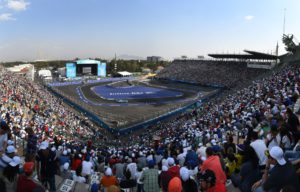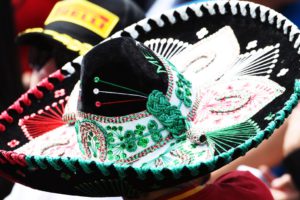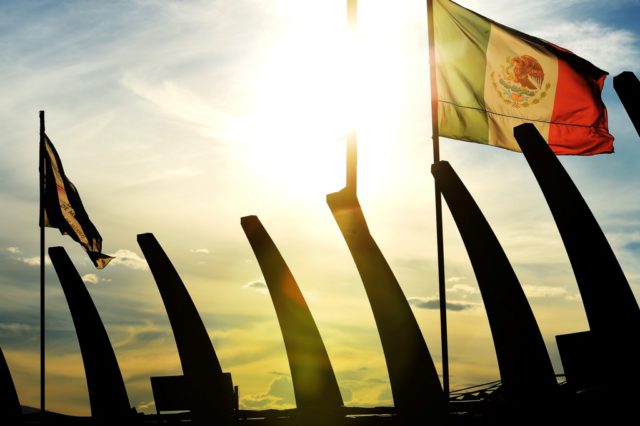The Mexico Grand prix is the 19th round of the 2018 Formula 1 World Championship.
Total number of race laps: 71
Complete race distance: 305.354 kilometers (189.738 miles)
Pit lane speed limit: 80 kph (50 mph)
This 4.304-kilometer (2.674-mile), 17-turn circuit has hosted Formula One since 1963. Last year’s Mexican Grand Prix served as the venue’s 18th grand prix.
Sebastian Vettel holds the race lap record at Autódromo Hermanos Rodríguez (1:18.785), set last year with Scuderia Ferrari.
Vettel also holds the qualifying lap record at Autódromo Hermanos Rodríguez (1:16.488), set last year during Q3.

Mexico and the Autódromo Hermanos Rodríguez have had three stints on the Formula One calendar
The first was an eight-year stretch between 1963-1970 before Formula One took a 15-year hiatus from the country. The globe-trotting series returned in 1986 and raced there until 1992. Twenty-two years passed until Formula One came back to Mexico, with the 2015 Mexican Grand Prix drawing a massive crowd estimated at 240,000.
To prepare for Formula One’s most recent return, the track underwent a comprehensive renovation. Noted track designer Hermann Tilke penned the new layout, which followed the general outline of the original course. The entire track was resurfaced, with new pit, paddock and spectator stands constructed. The most notable changes from the old layout to the current version were an added sequence of corners comprising turns one, two and three, along with a revised set of corners through the Foro Sol baseball stadium, which was built inside the famed and feared Peraltada corner, which serves as the track’s final turn.

DYK? The Mexican Grand Prix has been run 18 times, and every one of them has been at Autódromo Hermanos Rodríguez
However, when Mexico hosted its first grand prix in 1963, the track was called Magdalena Mixhuca. It was renamed in honour of local racing hero and Ferrari rising star Ricardo Rodríguez and his racing driver brother, Pedro, who scored two grand prix victories in a career that spanned 54 starts between 1963 and 1971. Ricardo was killed in a non-championship race at Magdalena Mixhuca in 1962. Pedro died in a sports car race in 1971 at the Norisring in Germany.
DYK? The Autódromo Hermanos Rodríguez is one of four Formula One locations with ties to the Olympics as the venue hosted numerous events during the 1968 Summer Olympics in Mexico City. Circuit de Barcelona – Catalunya, home to the Spanish Grand Prix, was the site of the start/finish line for the road team time trial cycling event when Barcelona hosted the 1992 Summer Olympics. Sochi, site of the Russian Grand Prix, hosted the 2014 Winter Olympics. Finally, the backstraight at the Circuit Gilles Villeneuve in Montreal runs adjacent to the Olympic rowing basin used during the 1976 Summer Olympics.
 During the course of the Mexico Grand prix, lows will range from 10-13 degrees Celsius (50-55 degrees Fahrenheit) to highs of 21-23 degrees Celsius (70-73 degrees Fahrenheit)
During the course of the Mexico Grand prix, lows will range from 10-13 degrees Celsius (50-55 degrees Fahrenheit) to highs of 21-23 degrees Celsius (70-73 degrees Fahrenheit)
Relative humidity ranges from 32 per cent (comfortable) to 86 per cent (very humid), with a dewpoint varying from 3 degrees Celsius/37 degrees Fahrenheit (dry) to 12 degrees Celsius/53 degrees Fahrenheit (very comfortable). The dew point is rarely below -4 degrees Celsius/25 degrees Fahrenheit (dry) or above 14 degrees Celsius/57 degrees Fahrenheit (comfortable). Typical wind speeds vary from 0-26 kph/0-16 mph (calm to moderate breeze), rarely exceeding 37 kph/23 mph (fresh breeze).

Focus points Altitude
The Autodromo Hermanos Rodriguez is situated at 2,200 metres, which is three times higher than F1’s next highest track (Interlagos in Brazil). The thinner air affects the cars in three significant ways. First, they produce less downforce. The cars run maximum downforce, yet they produce less aerodynamic grip than at Monza. Second, the internal combustion unit produces less power because there’s 75 per cent less oxygen than at sea level and, third, it’s harder to cool the car.
Most demanding section The Stadium (Turns 13-16). This is the slowest section on the lap and a lot of time can be lost if traction or turn-in are a problem. It’s easy for the drivers to lock the unloaded front tyre on the approach to Turn 13 and they have to be progressive with the throttle, or risk snap oversteer.
Unique difficulty Aerodynamics. The thin air allows cars to run similar wing levels to the Singapore Grand Prix. Yet they produce 10 per cent less downforce than at Monza – the lowest downforce track of the year. As a result, the cars produce very little drag and are spectacularly quick along the 1.3km/0.8-mile pit straight. The drivers are on full throttle for 15s and top speeds peak at 354km/h (220mph) just prior to the braking zone.

Braking The cars spend 16s per lap on the brakes
The hardest deceleration is into Turn One. There the cars slow from 354km/h (220mph) to 106km/h (66mph) in just 70 metres, with a peak longitudinal force of 4.2g. The high altitude makes brake cooling one of the trickiest engineering conundrums of the season.
Power The cars use 1.4kg of fuel per lap, with 47 per cent spent on full throttle.
Aero High downforce. The cars run maximum downforce yet produce less aerodynamic grip than at Monza. That is due to the thinner air at high altitude. The reduced drag from the cars results in some of the highest top speeds of the year along the pit straight.
Seeing the sights on the way to the Autódromo Hermanos Rodríguez for the #MexicoGP for @HulkHulkenberg and @Carlossainz55!
? by @Samsofy2#RSspirit pic.twitter.com/uE5SBRdriw
— Renault Sport F1 (@RenaultSportF1) October 24, 2018
































